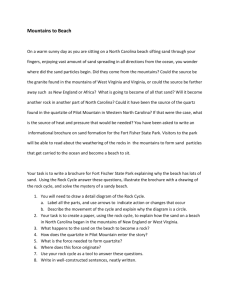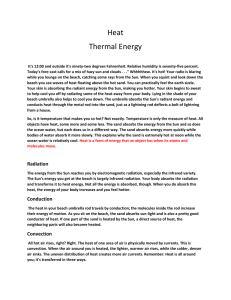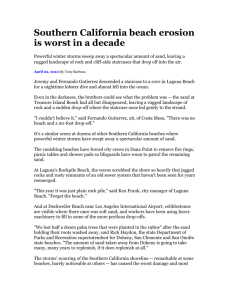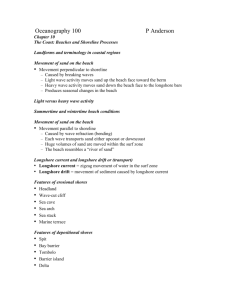Sand Management and Beach Restoration in the
advertisement
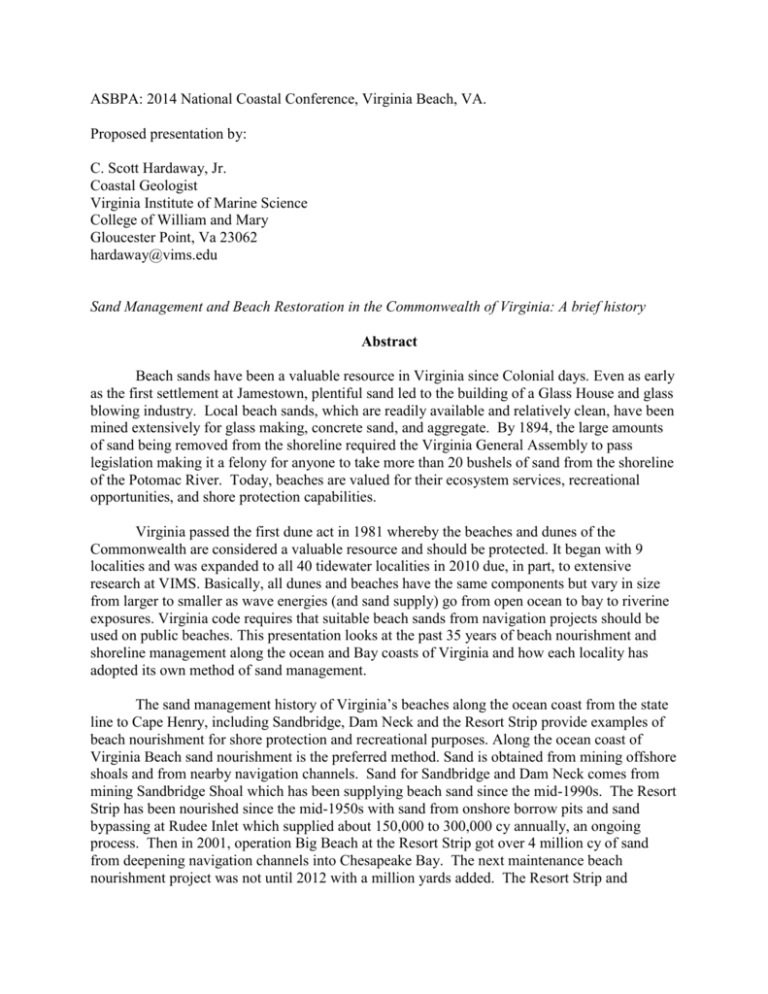
ASBPA: 2014 National Coastal Conference, Virginia Beach, VA. Proposed presentation by: C. Scott Hardaway, Jr. Coastal Geologist Virginia Institute of Marine Science College of William and Mary Gloucester Point, Va 23062 hardaway@vims.edu Sand Management and Beach Restoration in the Commonwealth of Virginia: A brief history Abstract Beach sands have been a valuable resource in Virginia since Colonial days. Even as early as the first settlement at Jamestown, plentiful sand led to the building of a Glass House and glass blowing industry. Local beach sands, which are readily available and relatively clean, have been mined extensively for glass making, concrete sand, and aggregate. By 1894, the large amounts of sand being removed from the shoreline required the Virginia General Assembly to pass legislation making it a felony for anyone to take more than 20 bushels of sand from the shoreline of the Potomac River. Today, beaches are valued for their ecosystem services, recreational opportunities, and shore protection capabilities. Virginia passed the first dune act in 1981 whereby the beaches and dunes of the Commonwealth are considered a valuable resource and should be protected. It began with 9 localities and was expanded to all 40 tidewater localities in 2010 due, in part, to extensive research at VIMS. Basically, all dunes and beaches have the same components but vary in size from larger to smaller as wave energies (and sand supply) go from open ocean to bay to riverine exposures. Virginia code requires that suitable beach sands from navigation projects should be used on public beaches. This presentation looks at the past 35 years of beach nourishment and shoreline management along the ocean and Bay coasts of Virginia and how each locality has adopted its own method of sand management. The sand management history of Virginia’s beaches along the ocean coast from the state line to Cape Henry, including Sandbridge, Dam Neck and the Resort Strip provide examples of beach nourishment for shore protection and recreational purposes. Along the ocean coast of Virginia Beach sand nourishment is the preferred method. Sand is obtained from mining offshore shoals and from nearby navigation channels. Sand for Sandbridge and Dam Neck comes from mining Sandbridge Shoal which has been supplying beach sand since the mid-1990s. The Resort Strip has been nourished since the mid-1950s with sand from onshore borrow pits and sand bypassing at Rudee Inlet which supplied about 150,000 to 300,000 cy annually, an ongoing process. Then in 2001, operation Big Beach at the Resort Strip got over 4 million cy of sand from deepening navigation channels into Chesapeake Bay. The next maintenance beach nourishment project was not until 2012 with a million yards added. The Resort Strip and associated beach is the economic driver for the City of Virginia Beaches tourist industry and indeed the economies of surrounding localities. Cape Henry (Fort Story) has a series of breakwaters along the coast which have benefitted from northward moving littoral sands and has resulted in wide stable shore planform. Entering the Bay, the Ocean Park shoreline in Virginia Beach is frequently nourished from maintenance dredging of Lynnhaven Inlet. Moving westward to the Norfolk coast, shoreline management has proceeded by implementing a shoreline management plan developed in 1992. This plan covers over 7 miles of shoreline and identified three Critical Areas which have been systematically addressed with detached breakwaters and beach nourishment. This plan is complete and ongoing modifications and maintenance efforts continue. Sand sources have included dredge material, upland sources, sand back passing and mining offshore shoals. The City of Hampton developed a Bay-front shoreline management plan in 1999. Hampton has acquired beach nourishment sands by mining Horseshoe Shoals from the mid1980s to the present with augmentation from upland borrow sites. The Buckroe public beach has three widely-spaced, headland breakwaters, which were installed in 3 phases and have provided longer- term residency for nourished material. Further north the Factory Point Breakwater system was installed in 2010 to rebuild/restore the spit at Factory Point. Beach sand for the project was obtained from mining nearby shoals in the Bay. Finally, farther up Bay at the mouth of the York River is Yorktown, where the historic surrender of Cornwallis to George Washington occurred. A busy seaport up until the Civil War, the town and waterfront had fallen into serious disrepair. Then, between 1995 and 2005, a series of headland breakwaters and beach nourishment were installed along 3,500 feet of the Yorktown coast in 3 phases. This breakwater system of stable, protective and recreational beaches provided the foundation for extensive waterfront revitalization with new shops, restaurants and additional parking as well as waterfront parks and walkways. The unique system of breakwaters and pocket beaches fit to the shore morphology on the upriver and downriver side of the Coleman Bridge. The tidal channel of the York River runs close to shore dropping to -80 feet about 100 feet offshore. This was conducive to the installation of a series of floating concrete breakwaters which provide docking for small and large vessels including cruise ships. All sand for the beaches was obtained from upland borrow sites.

